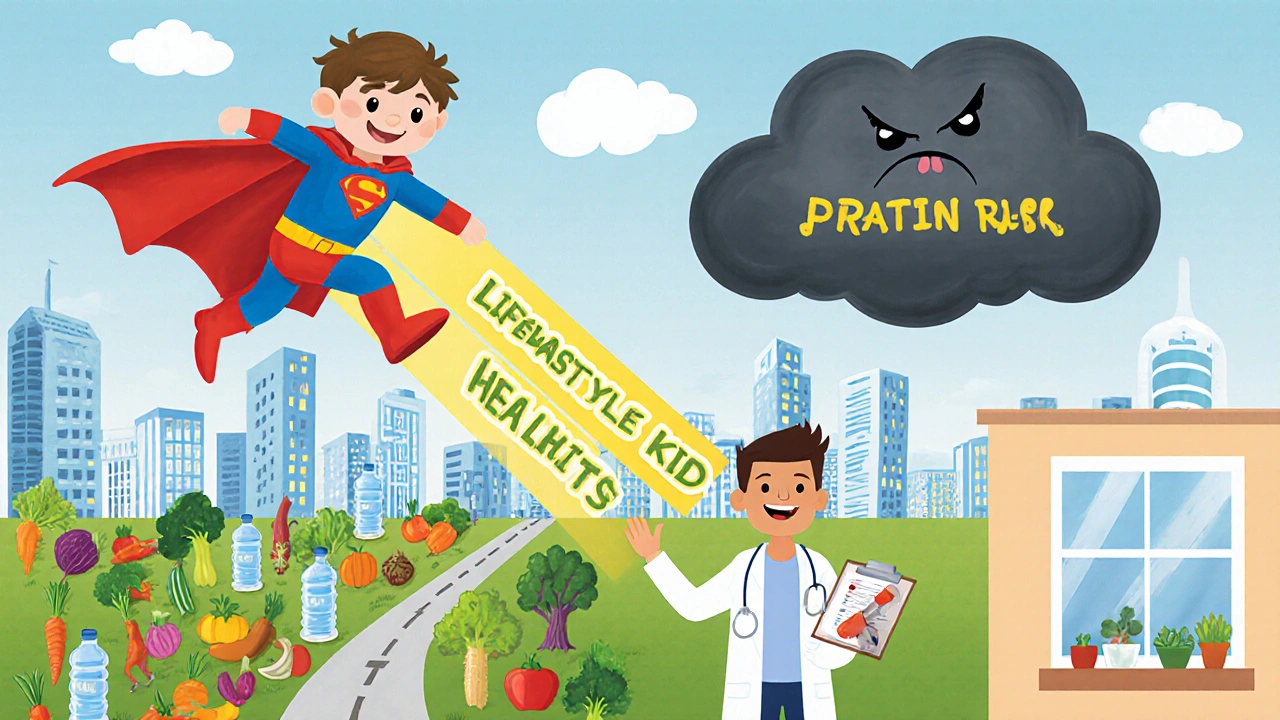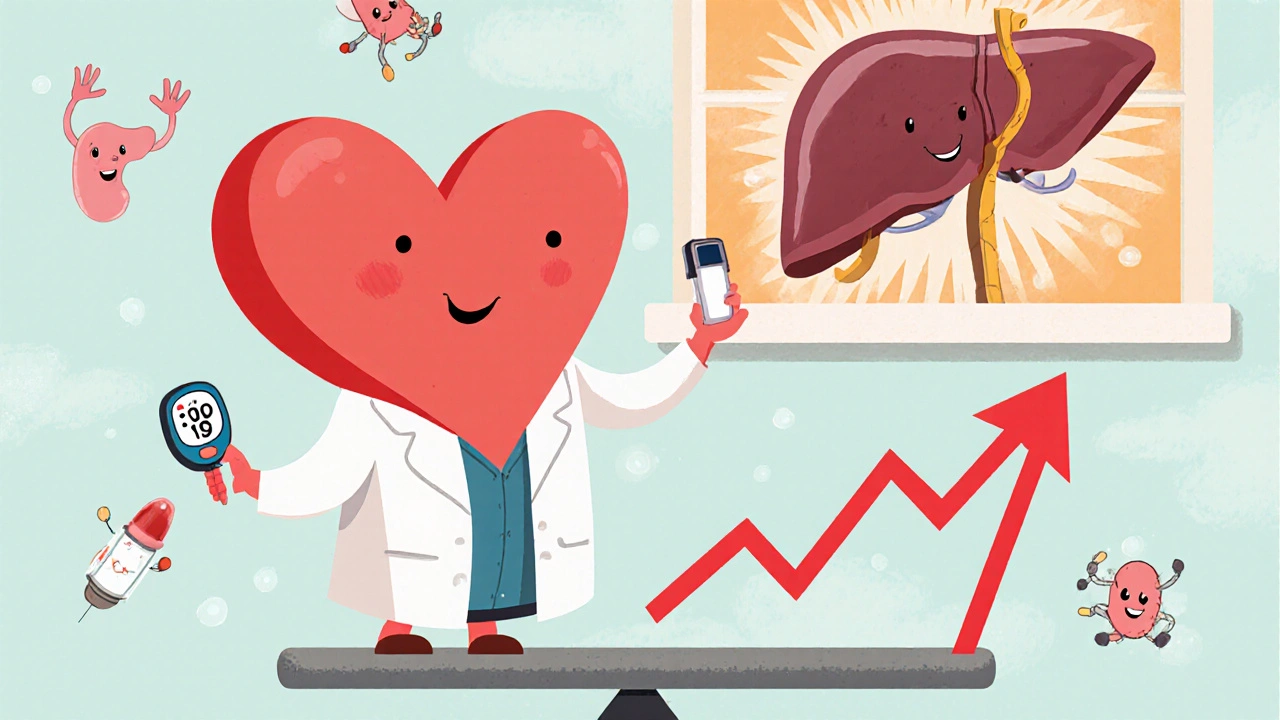Statins & Diabetes Risk Calculator
This tool helps estimate your risk of developing diabetes while taking statins based on your health factors. Results are for informational purposes only and not medical advice.
Your Risk Assessment
- Get a fasting glucose and HbA1c test before starting statins
- Work with your doctor to manage blood sugar levels
- Maintain healthy lifestyle habits
When you’re taking a statin to lower your cholesterol, you’re doing something good for your heart. But for some people, that same pill can nudge their blood sugar up - enough to cross the line into prediabetes or even type 2 diabetes. It’s not common, and it’s not inevitable, but it’s real. And if you’re already at risk for diabetes, you need to know about it.
Statins Aren’t Just for Cholesterol
Statins like atorvastatin, rosuvastatin, and simvastatin work by blocking a liver enzyme that makes cholesterol. That’s their job. But that same enzyme is part of a bigger system - the mevalonate pathway - that also helps produce molecules your body needs to move glucose into cells and make insulin work properly. When statins slow down this pathway, they accidentally interfere with how your body handles sugar.Research from the Cholesterol Treatment Trialists’ Collaboration, which tracked over 135,000 people, found that statin users had a slightly higher chance of being diagnosed with diabetes. The increase wasn’t huge - about 0.1% to 0.3% per year - but it added up across millions of users. And the higher the dose, the bigger the effect. People on high-intensity statins like 80 mg of atorvastatin saw a 36% higher risk compared to those on placebo. Lower doses still carried a 10% increased risk.
Why Does This Happen?
It’s not one thing. It’s two problems working together.First, statins make your cells less sensitive to insulin. That means your body needs more insulin to get glucose out of your blood and into your muscles and fat. A study of nearly 9,000 men in Finland showed insulin sensitivity dropped by 24% in statin users over six years.
Second, your pancreas tries to compensate by pumping out more insulin. But over time, the beta cells that make insulin get worn down. One study found insulin secretion dropped by 12% in people on statins. So you’re getting less insulin output at the same time your body needs more of it. That’s a recipe for rising blood sugar.
Some statins seem worse than others. Atorvastatin and rosuvastatin - the high-intensity ones - are most often linked to this effect. Simvastatin and pravastatin appear to have a smaller impact. But even the milder ones aren’t risk-free.
Who’s Most at Risk?
Not everyone on statins develops diabetes. The risk is concentrated in people who are already close to the edge.If you have:
- Prediabetes (fasting glucose between 100-125 mg/dL or HbA1c of 5.7%-6.4%)
- Obesity, especially around the waist
- High triglycerides and low HDL
- High blood pressure
- A family history of type 2 diabetes
- Been diagnosed with metabolic syndrome
- then you’re in the group where statins are most likely to tip you over into diabetes. Age matters too. People over 65 are more vulnerable. Women with a history of gestational diabetes are also at higher risk.
One study found that people with three or more of these risk factors had a 46% higher chance of developing diabetes while on statins. That’s why doctors now screen for these things before prescribing.

What Do Experts Say?
You might hear conflicting messages. Some people say, “Don’t take statins - they cause diabetes.” Others say, “The benefits far outweigh the risks.” Both are true.The American Heart Association, the American Diabetes Association, and the CDC all agree: for people who need statins, the heart protection they offer is worth the small diabetes risk.
Here’s the math: For every 1,000 people taking a statin for five years, about 15 heart attacks or strokes are prevented. Meanwhile, only 2 to 3 new cases of diabetes are expected. That’s a net gain of 12 to 13 lives saved or major events avoided.
Dr. Steven Nissen from Cleveland Clinic puts it plainly: “We don’t stop giving statins because of the diabetes risk. We manage the diabetes risk while giving the statin.”
What Should You Do?
If you’re on a statin and worried about your blood sugar, here’s what actually helps:- Get tested. Ask your doctor for a fasting glucose test and HbA1c before you start the statin, and again after 3-6 months. If your numbers creep up, you’ll catch it early.
- Don’t stop the statin. Stopping it without medical advice can increase your risk of heart attack or stroke. If your blood sugar rises, your doctor can adjust your treatment - not necessarily your statin.
- Change your lifestyle. Losing 5-7% of your body weight, walking 150 minutes a week, and cutting out sugary drinks and refined carbs can reduce your diabetes risk by more than 50%. These changes work even better than metformin for preventing diabetes.
- Ask about statin type and dose. If you’re on high-dose atorvastatin and have multiple risk factors, your doctor might switch you to a lower dose or a different statin like pravastatin or fluvastatin, which have less impact on glucose.
- Monitor your numbers. If you already have diabetes, statins can make your blood sugar harder to control. Check your levels more often and talk to your doctor about adjusting your diabetes meds if needed.

It’s Not All Bad News
Many people take statins for years and never see a change in their blood sugar. In fact, most don’t. The risk is real, but it’s not guaranteed. And for people with heart disease, blocked arteries, or a history of heart attack, the statin is life-saving.There’s also good news on the horizon. Researchers are looking for genetic markers that predict who’s more likely to get diabetes on statins. One study found that people with certain variants in the SLCO1B1 gene had a much higher risk. In the future, a simple blood test might help doctors pick the safest statin for you.
The Bottom Line
Statins don’t cause diabetes in most people. But for those already on the edge, they can push them over. That’s why screening and lifestyle changes matter more than ever.If you’re taking a statin, don’t panic. Do this: get your blood sugar checked, eat better, move more, and talk to your doctor about your personal risk. Don’t let fear stop you from protecting your heart - but don’t ignore the warning signs either. The goal isn’t to avoid statins. It’s to use them wisely.
Do statins cause diabetes?
Statins don’t cause diabetes in most people, but they can increase the risk slightly in those who are already at risk - like people with prediabetes, obesity, or metabolic syndrome. Studies show a 10% to 36% higher chance of developing type 2 diabetes depending on the dose. The effect is small overall but real for vulnerable individuals.
Which statin has the least impact on blood sugar?
Pravastatin and fluvastatin appear to have the smallest effect on blood sugar levels. Atorvastatin and rosuvastatin - especially at high doses - are more likely to raise glucose. If you’re at risk for diabetes, your doctor might choose one of the milder statins or lower the dose to reduce the risk.
Should I stop taking statins if my blood sugar rises?
No. Stopping statins without medical advice increases your risk of heart attack or stroke far more than the risk of developing diabetes. Instead, talk to your doctor. They may adjust your statin, add a diabetes medication like metformin, or recommend lifestyle changes to bring your blood sugar back under control.
Can lifestyle changes prevent statin-induced diabetes?
Yes. Losing just 5-7% of your body weight, exercising 150 minutes a week, and cutting out sugary foods can reduce your risk of developing diabetes by more than half - even while on statins. Lifestyle changes are often more effective than medication at preventing diabetes in high-risk people.
How often should I check my blood sugar if I’m on statins?
If you’re at risk for diabetes (prediabetes, obesity, high blood pressure), get a fasting glucose and HbA1c test before starting statins, then again at 3-6 months. If your numbers are stable, annual checks are usually enough. If they rise, your doctor may check every 3-4 months until things stabilize.
Do statins make diabetes worse if I already have it?
Yes, in some cases. People with existing type 2 diabetes may find their blood sugar harder to control on statins, especially high-intensity ones like atorvastatin. You may need to adjust your diabetes medications. Don’t stop the statin - work with your doctor to manage both conditions together.


Statins are a classic example of medical trade-offs - you’re trading a tiny, manageable risk of elevated blood sugar for a massive reduction in heart attacks and strokes. The data is clear: for every 1,000 people on statins, you prevent 15 major cardiovascular events and only see 2-3 new diabetes cases. That’s not a side effect; it’s a calculated trade, and the math overwhelmingly favors keeping the statin. The real danger isn’t the pill - it’s people stopping it because they read a scary headline.
As someone who’s been on pravastatin for 8 years and had prediabetes before starting, I can tell you - lifestyle changes made all the difference. I lost 12% of my body weight, started walking 5K every morning, and cut out soda completely. My HbA1c dropped from 6.1 to 5.4. The statin didn’t cause my diabetes - my diet and inactivity did. The statin just made me pay attention. Don’t blame the medicine - blame the donuts.
I appreciate how balanced this post is. Too often, people either demonize statins or treat them like magic bullets. The truth is in the middle - they’re powerful tools, but they require awareness. If you’re at risk for diabetes, get your numbers checked before and after starting. Don’t wait until you’re in full-blown diabetes to act. Prevention isn’t optional - it’s non-negotiable. And yes, walking 150 minutes a week is more effective than most pills. Your feet are your first line of defense.
Let’s not sugarcoat this - the pharmaceutical industry profits from both statins and metformin. The mevalonate pathway disruption is well-documented, yet the FDA still greenlights high-dose atorvastatin for everyone. Why? Because the ROI on statins is astronomical. But let’s be real: if you’re 65, obese, and have metabolic syndrome, you’re not just at risk - you’re a walking clinical trial. The real scandal isn’t the statin - it’s that we don’t screen for genetic markers like SLCO1B1 before prescribing. We’re playing Russian roulette with metabolic health.
I’ve been on a low-dose rosuvastatin for three years. My LDL dropped from 160 to 75. My fasting glucose went from 98 to 112. I didn’t panic. I talked to my doctor. We switched me to pravastatin, added a metformin low dose, and I started doing yoga three times a week. My glucose is back to 96 now. This isn’t a crisis - it’s a management opportunity. Statins aren’t the enemy. Ignorance is.
My mom was on atorvastatin 40mg and developed type 2 diabetes within a year. She didn’t have any risk factors before. The doctor said it was ‘coincidence.’ I don’t believe in coincidence. If a drug pushes someone over the edge, it’s not harmless. People need to know this isn’t just a ‘minor’ risk - it’s life-altering. Why isn’t there a mandatory glucose monitoring protocol before prescribing? Because it costs money. And that’s the real story.
Statins are just the tip of the iceberg. The real problem? They’re pushing us toward a pharmaceutical monoculture where every problem gets a pill. What if the answer isn’t more drugs - but less processed food? Less sitting? More sleep? We’ve turned medicine into a vending machine. And now we’re surprised when the machine breaks down?
...and yet... people still take them... because... they’re scared... of heart attacks... but not scared... enough... to change their diet... or... exercise... or... sleep... or... stop drinking soda... or... quit smoking... or... lose weight... or... reduce stress... or... stop watching TV... all day... or... eat vegetables... or... drink water... or... walk... or... breathe... or... care... about themselves... enough... to... try... anything... else... before... the... pill...
Let’s analyze the data with precision. The Cholesterol Treatment Trialists’ Collaboration cohort of 135,000 subjects demonstrated a statistically significant increase in diabetes incidence among statin users, with a hazard ratio of 1.13 (95% CI: 1.07–1.19) for moderate-intensity and 1.36 (95% CI: 1.27–1.46) for high-intensity regimens. The absolute risk increase, while small, is clinically meaningful in populations with preexisting metabolic dysfunction. The mevalonate pathway’s inhibition reduces isoprenoid synthesis, impairing GLUT4 translocation and insulin signaling - a direct molecular mechanism, not mere correlation. Furthermore, beta-cell dysfunction manifests as reduced first-phase insulin secretion, as confirmed by hyperglycemic clamps in randomized trials. The differential effect among statins correlates with lipophilicity and hepatic uptake - pravastatin’s hydrophilicity and OATP1B1-independent transport confer metabolic neutrality. Therefore, clinical decision-making must integrate genetic pharmacogenomics, baseline metabolic phenotype, and cardiovascular risk stratification - not population averages. This is precision medicine, not population medicine.
I’m a nurse. I’ve seen this happen. A woman, 68, with high cholesterol, no diabetes, started on atorvastatin. Three months later - fasting glucose 132. She cried. Thought she failed. But she didn’t. She just needed better guidance. We switched her to pravastatin, started her on a diabetes prevention program, and now she’s hiking every weekend. Her glucose is normal. Her heart is safe. She’s alive. This isn’t about fear. It’s about care. Talk to your doctor. Don’t stop. Don’t panic. Just adjust.
I didn’t know statins could affect blood sugar. I’m on one because my dad had a heart attack. Should I be worried? I’m 52, overweight, but I walk every day. I don’t eat much sugar. Should I get tested? What’s the easiest way to check? I don’t want to panic but I don’t want to be blind either.
Big Pharma. They know. They don’t care. They profit from both the statin and the diabetes drug. It’s a loop. You’re being used.
People take statins like candy. You think you’re being smart by lowering cholesterol - but you’re just delaying the inevitable by poisoning your pancreas. You think you’re saving your heart? You’re just trading one organ for another. And now you’ll need insulin for the rest of your life. Congratulations. You’ve won the metabolic lottery - the one where everyone else loses.
Here’s the truth no one will say: statins are overprescribed. They’re given to people with 1% 10-year risk because guidelines got lazy. And then when people get diabetes, we blame their lifestyle - but we never ask why we gave them a drug that was never meant for them in the first place. The real epidemic isn’t diabetes - it’s medical overreach. Stop treating cholesterol like a villain. Treat it like a symptom. Fix the root cause - inflammation, insulin resistance, poor diet - not the cholesterol number on a lab report.